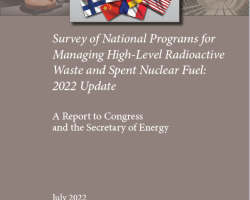Category of Content
Siting Experience Documents Only
Publication Date
Subject Matter
Update to Thermodynamic Database Development and Sorption Database Integration
Update to Thermodynamic Database Development and Sorption Database Integration
Consensus on Salt Field Test Design
Consensus on Salt Field Test Design
Mechanical Behavior of the Near-field Host Rock Surrounding Excavations
Mechanical Behavior of the Near-field Host Rock Surrounding Excavations
Draft of M2 Report on Integration of the Hybrid Hydride Model into INL’s MBM Framework for Review
Draft of M2 Report on Integration of the Hybrid Hydride Model into INL’s MBM Framework for Review
International Collaborations on Engineered Barrier Systems: Experimental and Modeling Investigations Report
International Collaborations on Engineered Barrier Systems: Experimental and Modeling Investigations Report
Argillite Disposal R&D International Collaborations interim report - 2019
Argillite Disposal R&D International Collaborations interim report - 2019
Investigation of Coupled THMC Processes and Reactive Transport FY14 Progress
Investigation of Coupled THMC Processes and Reactive Transport FY14 Progress
Argillite Disposal R&D – LANL (FY19)
Argillite Disposal R&D – LANL (FY19)
Draft Test Plan for Brine Migration Experimental Studies in Run-of-Mine Salt Backfill
Draft Test Plan for Brine Migration Experimental Studies in Run-of-Mine Salt Backfill
Verification and Validation Strategy for Implementation of Hybrid Potts-Phase Field Hydride Modeling Capability in MBM
Verification and Validation Strategy for Implementation of Hybrid Potts-Phase Field Hydride Modeling Capability in MBM
EBS Model Development and Evaluation Report
EBS Model Development and Evaluation Report
ADVANCED NUCLEAR FUEL CYCLE EFFECTS ON THE TREATMENT OF UNCERTAINTY IN THE LONG TERM ASSESSMENT OF GEOLOGIC DISPOSAL SYSTEMS EBS INPUT?
ADVANCED NUCLEAR FUEL CYCLE EFFECTS ON THE TREATMENT OF UNCERTAINTY IN THE LONG TERM ASSESSMENT OF GEOLOGIC DISPOSAL SYSTEMS EBS INPUT?
ANL Mixed Potential Model with Experimental Results: Implementation of Noble Metal Particle Catalysis Module
ANL Mixed Potential Model with Experimental Results: Implementation of Noble Metal Particle Catalysis Module
Experimental Investigation of Two-Phase Flow in Rock Salt
Experimental Investigation of Two-Phase Flow in Rock Salt
An Updated Analysis of Clad Degradation
An Updated Analysis of Clad Degradation
An Updated Analysis of Clad Degradation
An Updated Analysis of Clad Degradation
ADVANCED NUCLEAR FUEL CYCLE EFFECTS ON THE TREATMENT OF UNCERTAINTY IN THE LONG-TERM ASSESSMENT OF GEOLOGIC DISPOSAL SYSTEMS – NATURAL SYSTEM INPUT
ADVANCED NUCLEAR FUEL CYCLE EFFECTS ON THE TREATMENT OF UNCERTAINTY IN THE LONG-TERM ASSESSMENT OF GEOLOGIC DISPOSAL SYSTEMS – NATURAL SYSTEM INPUT
FY15 Report on Lab Thermomechanical Testing
FY15 Report on Lab Thermomechanical Testing
FY12 Sensitivity Studies Using the UFD Clay Generic Disposal System Model
FY12 Sensitivity Studies Using the UFD Clay Generic Disposal System Model
Experiments and Modeling in Support of Generic Salt Repository Science
Experiments and Modeling in Support of Generic Salt Repository Science
Analysis of Data From Salt Reconsolidation Experiments at SNL in FY12 and FY13
Analysis of Data From Salt Reconsolidation Experiments at SNL in FY12 and FY13
Guidance for Creating a Community Benefits Plan for Regional Direct Air Capture Hubs
Guidance for Creating a Community Benefits Plan for Regional Direct Air Capture Hubs
This document is intended to provide supplemental information to assist applicants developing a Community Benefits Plan (CBP) for the Regional Direct Air Capture Hubs. As shown in the graphic to the right, Community Benefits Plans are based on a set of four core interdependent policy priorities: engaging communities and labor; investing in America's workforce; advancing diversity, equity, inclusion, and accessibility; and implementing Justice40.
Policies for Achieving Energy Justice in Society: Best Practices for Applying Solar Energy Technologies to Low-Income Housing
Policies for Achieving Energy Justice in Society: Best Practices for Applying Solar Energy Technologies to Low-Income Housing
Studies indicate that the energy burden — energy costs as a percentage of annual family income — on low-income families is inordinately high, compared to that of the rest of the population. Rising fuel costs exacerbate this problem. Residential solar energy systems can help address this situation by furnishing a price-stable energy source with the added benefit of reduced greenhouse gas emissions. However, without appropriate incentives, these systems are prohibitively expensive for low-income families.
Survey of National Programs for Managing High-Level Radioactive Waste and Spent Nuclear Fuel: 2022 Update
Survey of National Programs for Managing High-Level Radioactive Waste and Spent Nuclear Fuel: 2022 Update
In October 2009, the U.S. Nuclear Waste Technical Review Board (Board or NWTRB) published Survey of National Programs for Managing High-Level Radioactive Waste and Spent Nuclear Fuel. For each of the 13 national programs studied, the report catalogued 15 institutional arrangements that had been set in place and 15 technical approaches that had been taken to design repository systems for the long-term management of high-activity radioactive waste.

